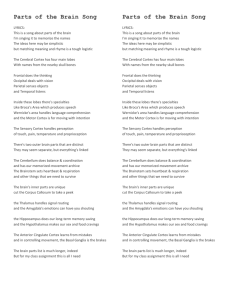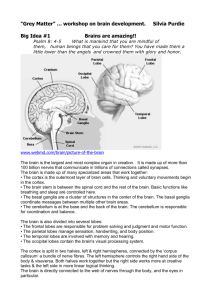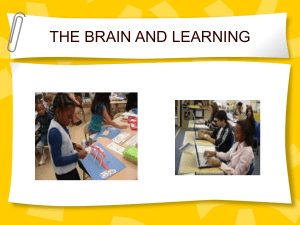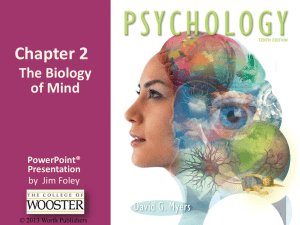Association cortex (Ch 25)
advertisement
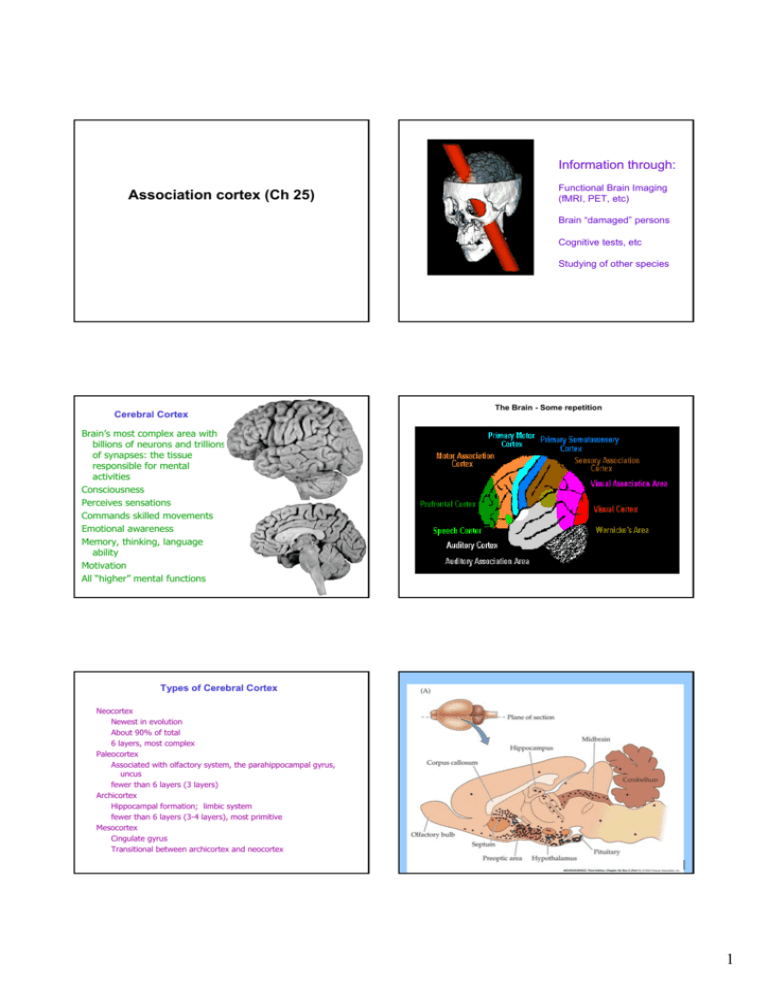
Information through: Association cortex (Ch 25) Functional Brain Imaging (fMRI, PET, etc) Brain “damaged” persons Cognitive tests, etc Studying of other species Cerebral Cortex The Brain - Some repetition Brain’s most complex area with billions of neurons and trillions of synapses: the tissue responsible for mental activities Consciousness Perceives sensations Commands skilled movements Emotional awareness Memory, thinking, language ability Motivation All “higher” mental functions Types of Cerebral Cortex Neocortex Newest in evolution About 90% of total 6 layers, most complex Paleocortex Associated with olfactory system, the parahippocampal gyrus, uncus fewer than 6 layers (3 layers) Archicortex Hippocampal formation; limbic system fewer than 6 layers (3-4 layers), most primitive Mesocortex Cingulate gyrus Transitional between archicortex and neocortex 1 Histology of the Cerebral Cortex 2 main cell types are pyramidal and granule cells Pyramidal cells have large apical dendrite and basal dendrites Axon projects downward into subcortical white matter Pyramidal cell is the primary output neuron Granule (stellate) cells are interneurons Short dendrites extending in all directions Short axon projecting to adjacent pyramidal cells Granule cells are especially numerous in sensory and association cortex Neocortex has 6 layers designated I, II, III, IV, V, VI Pyramidal cells predominate in layers III and V Granule cells in layers II and IV Types of Cortex Cytoarchitecture varies in different areas Number and size of cells Thickness of layers PN26BA0.JPG A More Detailed Look at Cortical Lamination Cortical Columns (minicolumn – macro/hypercolumn) Brodmanns areor Functional units are cortical columns Columns are vertically oriented groups of thousands of neurons in synaptic contact Main input layer is layer IV which receives thalamic input Thalamus is the main source of input to the cortex PN26022.JPG Structure of the Human Neocortex Including Association Cortices 2 Human foetal columns at ~26 gestational weeks Buxhoeveden, D. P. et al. Brain 2002 125:935-951 . PN26030.JPG Canonical Neocortical Circuitry – 6 layers 3 Functional Histology - summary Layers V and VI = output V to Basal ganglia, brainstem and spinal cord VI to thalamus Layers I, II, III = associative; projecting to cortical areas Layer IV = layer receiving inputs from thalamus and other cortical areas Views of the Human Brain Showing the Extent of the Association Cortices PN26040.JPG Summary of the Overall Connectivity of the Association Cortices PN26010.JPG 4 Associative cortical regions The Brain: Lobes Occipital Lobes Temporal Lobes Parietal Lobes Frontal Lobes (sometimes also Limbic Lobes Insular Lobes) Neuroanatomy - Parietal Lobes Parietal Neglect Syndrome Failure to recognize side of body contralateral to injury May not bathe contralateral side of body or shave contralateral side of face Deny own limbs Functions: • Sensory integration, visual attention, perceptual awareness, attention Objects in contralateral visual field ignored Lesions can cause: • Neglect, inattention, dyscalculia, anomia, agraphia (writing problems), alexia (reading problems), apraxia (orient to sound) PN26061.JPG Locations of the Underlying Lesions in Patients Diagnosed With Contralateral Neglect Syndrome PN26062.JPG Locations of the Underlying Lesions in Patients Diagnosed With Contralateral Neglect Syndrome 5 Neuroanatomy - Temporal Lobes The Right Parietal Cortex of Normal Subjects is Highly Active During Tasks Requiring Attention Functions: • Memory, auditory processing, object recognition and identifying, naming Note: “better” to damage left part Lesions can cause: • Amnesia, Wernicke’s aphasia (more if left side affected), agnosias, prosopagnosia (if right side damaged - faces not recognized), category specific deficits. Neuroanatomy - Frontal Lobes Can be divided into: • Motor: Control of movement - weakness / paralysis • Premotor: Integration of motor skills / learned action - uncoordinated movements / impaired motor skills / speech • Prefrontal: Complex cognitive functions - difficulties with planning / decision making / inhibition / memory / attention / perseveration / personality changes / aphasia etc etc. Neuroanatomy - Occipital Lobes PN26BB0.JPG Psychosurgery Typical experimental approaches – role of different lobe neurons: Functions: • Sensory integration, visuoperception, vision Lesions can cause: • Heminopia, Blindsight, Visual Agnosia, Colour Agnosia PN26092.JPG Recording From Single Neurons in the Brain of an Awake, Behaving Rhesus Monkey 6 “Attention” neuron PN26101.JPG Selective Activation of Neurons in the Parietal Cortex During Fixation of a Significant Visual Target Selective Activation of Neurons in the Parietal Cortex During Fixation of a Significant Visual Target PN26102.JPG “Recognition” neuron Selective Activation of Face Cells in the Inferior Temporal Cortex of a Rhesus Monkey PN26112.JPG PN26111.JPG Selective Activation of Face Cells in the Inferior Temporal Cortex of a Rhesus Monkey Finding “Planning” neurons “Recognition” neuron PN26113.JPG Selective Activation of Face Cells in the Inferior Temporal Cortex of a Rhesus Monkey Activation of Neurons Near the Principal Sulcus of the Frontal Lobe During Delayed Response Task PN26121.JPG 7 “Planning” neurons Cellular evidence supports the importance of continuous activity Correct response Neuron does not continue to fire during delay period; animal makes incorrect response PN26122.JPG Activation of Neurons Near the Principal Sulcus of the Frontal Lobe During Delayed Response Task Very Complex Functions - Example Phenomena observed: - experiences felt “realistic” - vestibular sensations, floating - “egocentric” perspective lost Blanke et al, Nature 419:269-70, 2002 and Blanke et al, Brain 127:243-258, 2004 Neuropsychological Testing – Wisconsin Card Sorting Task Neuropsychological Testing – Stroop Interference Test Testing: GREEN YELLOW BLUE BLUE YELLOW GREEN BLUE RED Attention Automaticity Learning Response Selection Word Reading Color cognition rabbit 8 The hardware of cognition: The neocortex association regions. Anatomy of the mind – more complete view Cognition (perception and memory) Neocortex and hippocampus Affect (feeling and expression) Amygdala-hippocampus and cingulate Conation (thinking and action) Prefrontal cortex and basal ganglia Mamillary body Dorsal prefrontal Inferior parietal Superior temporal Thalamus Ant thalamic nuclei Cingulate Fornix Amygdala Hippocampus The hardware of emotions: The limbic system. The hardware of “executive” functions: The corticostriatal structures. Dorsolateral PFC ( executive) Caudate Ventromedial v PFC and Putamen Cingulate ( evaluative) 28.4 Modern conception of the limbic system. (Part 1) Association cortex Selective attention Working memory Storage Consolidation Arousal Thalamus Sensory inputs Hippocampus Disorders of Perception and memory: ADHD, Schizophrenia, Alzheimer’s 9 Association cortex Prefrontal cortex Working memory Selective attention Selective attention Storage Cingulate Cingulate Working memory Frontal executive system Motor system, Basal ganglia, cerebellum Storage Emotional experience Arousal Thalamus Sensory inputs Emotional encoding Consolidation Amygdala Hippocampus Hypothalamus Endocrine Autonomic Disorders of emotion regulation Emotional encoding Arousal Thalamus Amygdala Consolidation Hippocampus Disorders of executive functions psychosis, OCD. Sensory inputs Anxiety, Depression, PTSD Neurochemical systems involved Norepinephrine • Flight/Fight/Fright Dopamine • Pleasure seeking/executive Serotonin • Appetitive functions Acetylcholine • Memory, arousal GABA • Inhibitory Glutamate • Excitatory Box D Brain Size and Intelligence Study questions for The Association Cortices 1. Describe the basic organizational features of neocortex, shared by association cortices and sensory and motor cortices. 2. What features distinguish association cortices from sensory and motor cortices? Consider thalamic input and corticocortical connections. 3. How did Brodmann decide where to put the boundaries between Brodmann’s areas? 4. What are the main function(s) of each of the following? What techniques and approaches have been used to reveal these functions? parietal association cortex temporal association cortex frontal association cortex 5. What does the study of agnosias contribute to cognitive neuroscience? 6. What does contralateral neglect syndrome suggest about the neuroanatomy of attention? Why does contralateral neglect result from damage to the right, but not left, parietal lobe cortex? 7. Where and what are “recognition neurons”? “planning neurons”? “attention neurons”? 8. What cortical region is particularly critical for the delayed response task? 9. Is brain size a good measure of intelligence? 10. Other terms to know: cognition apraxia cytoarchitectonic prosopagnosia 10

